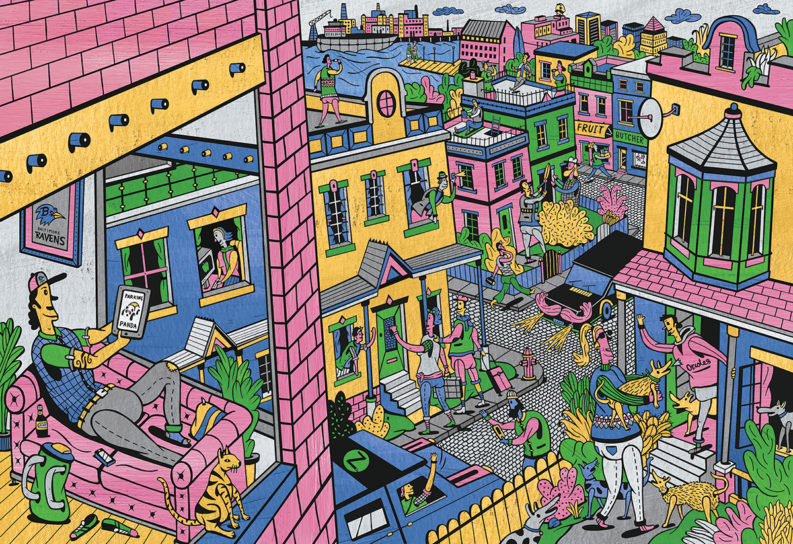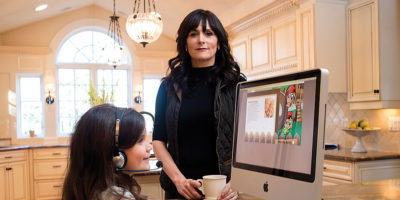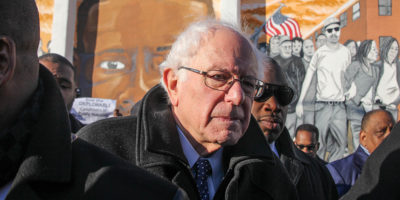Something about the empty driveway next to his off-campus house in Georgetown always bugged Nick Miller. But he couldn’t quite put his finger on it. Not until a trip to a Baltimore Ravens’ game took him through Federal Hill. There, driving with friends, desperate for parking, Miller saw residents holding up cardboard signs advertising spaces for rent. And it hit him. Sure, parking demand reaches naturally epic proportions on game days around M&T Bank Stadium; Miller, who grew up in Harford County, knew that. But finding convenient downtown parking in Baltimore and Washington, D.C., was always like searching for a needle in a haystack. Could digital technology, he wondered, fill those empty driveways, lots, and parking pads with actual cars in real time?
Brainstorming with computer programmer Adam Zilberbaum at the first Baltimore StartUp weekend, Miller’s epiphany led to a prototype for a user-friendly, peer-to-peer parking website and app. That was three years ago. Today, Parking Panda, which receives a cut of all transactions, makes locating and reserving a parking spot as easy as purchasing a seat online at Center Stage or Camden Yards. To date, Miller—just 25, low-key, and usually unshaven—and Zilberbaum, 31, have raised nearly $5 million in financing. They’ve added 18 employees, expanded to 40 cities, and bolstered their operation to include commercial parking garages.
But if their concept was merely a one-off success, albeit a welcome help to alleviating downtown traffic woes, it would just be a nice entrepreneurial story and end there. It doesn’t. It barely scratches the surface.
When Miller——who today bikes from his Fells Point apartment to his Federal Hill office—travels out of town, he does what a rapidly multiplying number of young adults do: He seeks out similar peer-to-peer services. Rather than dropping a couple hundred dollars on an impersonal hotel for a few of nights, he finds an inexpensive room he likes—and maybe interesting hosts—online via Airbnb, which enables almost anyone to turn their home or apartment into a B&B by renting a spare bedroom. Instead of wasting money on a rental car that will mostly sit idle, he’ll go to his smartphone to hook up with a Zipcar, hop a ride with a Lyft driver, or tap Uber’s taxi-on-demand app. In D.C., he might use the city’s massive bike-sharing program.
All of which, like Airbnb, and a laundry list of related platforms, are taking hold in Baltimore, too.
In fact, when Miller and Zilberbaum first began developing Parking Panda, they were harbingers of a profound cultural shift. Enabled by mobile technology, pushed by changing millennial values emphasizing sustainability and creativity, and fanned by the economic slowdown—it’s a transformation described as “the sharing economy.” Simply put, the people born between 1980 and 1994—the largest and most educated generation in U.S. history—are choosing to live differently and reshaping how cities, including Baltimore, function at basic levels.
“There are many different factors at work, and it can be difficult to separate cause and effect,” says Susan Shaheen, co-director of the University of California, Berkeley’s Transportation Sustainability Research Center. “There’s been the wholesale introduction of wireless smartphones and applications, but there’s also been a dramatic change in the younger population—a reduction in the number of people getting driver’s licenses—and a deliberate move away from suburban lifestyles. This generation wants to live in urban areas with the culture and community that affords and not have the burden of vehicle ownership.”
Raised on “sharing” models from Napster to Spotify to Netflix—millennials have also been referred to as “the cheapest generation.” Partly, this was born out of necessity, things like exploding college debt and a horrific job market. But millennnials always seemed fundamentally opposed to paying for things previous generations took for granted—like music, newspapers, and cable TV. Now, they’re not buying cars and houses at the rates of previous generations. And, they are the first generation, according to a recent study, to value their smartphones over their cars.
For them, it’s not much of a leap to use digital technology to share bicycles, handsaws (NeighborGoods), used clothes (thredUP), automobiles (RelayRides), pet-sitting duties (DogVacay)—or even an apartment for a few nights. Especially if it’s more convenient, less expensive, and maybe offers a more rewarding personal transaction—another millennial value. (It’s called social media for a reason.)
Got the money, but not the time? Find someone on Taskrabbit to run that errand. Need funding for your nonprofit? Indigogo can help. Cash to make a movie? Baltimore filmmaker Lotfy Nathan raised more than $30,000 for his documentary, 12 O’Clock Boys. Even though millennials aren’t going to stores to buy music or movies, they will support something they care about—if they can feel like a part of the project.
“I think what Parking Panda, Zipcar, or Uber, Airbnb, and these models do really well is more efficiently utilize existing resources,” Miller says. “I think this generation is hardwired to think that way. There’s a move toward ‘experience’ and away from ownership.” If it’s more adventurous, like jumping in the front seat of a hot pink-mustachioed Lyft car, charging your phone, and chatting with the driver—probably about the same age—or getting the insider tip on the best neighborhood dive bar from an Airbnb host, all the better.
To listen to Miller, it was the desire for efficient logistics and creative opportunities that led him to move into the city. “I love it, but I didn’t necessarily anticipate that growing up [in a rural county],” he says. “I can walk to Canton Square. There’s a culture, an art scene, museums. I like to do a lot of things, and all that’s possible because of the neighborhood I live in.”
Of course, the new peer-to-peer models don’t just afford the chance to save hard-to-come-by wages, but generate income on the other side of the equation. Shaina and Trevor Holman, both in their late 20s and from suburban North Carolina, decided to buy a house in Hollins Market when she got accepted into the University of Maryland School of Dentistry. “Our parents were like, ‘Buy a house in the city?,’” Holman laughs. “But we found this neighborhood that is a really a good fit.” They get by with one car—a “car-lite” household—because she can walk to school. And, for the past year, they’ve made between $900 and $1,600 a month renting a bedroom on Airbnb.
Holman learned about Airbnb from a neighbor, who earned enough to quit her full-time job and launch a start-up company. Three other neighbors are also renting rooms now, and her husband, once his contract job expired, launched his photography business while the extra income was streaming in. Holman admits that, initially, there was a bit of an “ick factor” about inviting strangers into their home, but she got past it. “It’s amazing how quickly you become friends with some of the guests,” Holman says. She recommends nearby Zella’s Pizzeria and CUPS Coffeehouse to visitors and helps them navigate the city. “We still keep in touch with people who were here just for two nights.”
A large factor in the confidence in peer-to-peer models like Airbnb, Holman notes, is that people on both ends are required to register online, get verified through social media like Facebook, and then provide user reviews. “Like Yelp,” she chuckles. “I was nervous about that, too, but it makes everyone want to leave a good impression.”
In terms of how the new business models are playing out in urban areas, physically it’s most apparent in transportation. Some cities have wrestled with regulating the peer-to-peer models, but Baltimore, so far, has taken a hands-off approach.
Billy Hwang, of the Baltimore City Department of Transportation, and a Gen-Xer, can’t help but laugh when he hears Shaheen’s phrase, “the burden of vehicle ownership” repeated. He sounds stunned by how fast changing millennial priorities and emerging technology have affected urban planning.
“In my generation, the first thing you did when you turned 16 was take your driver’s test,” Hwang says. “Now, you look at something like bike-sharing. Five years ago, that was a farfetched idea.
“The iPhone sparked a revolution that’s been spilling over into transportation for the last two to three years,” Hwang continues. “We’ve never seen anything like this—where non-transportation technology is driving changes in transportation.” Wireless radio-frequency identification, for example, is what enables Zipcar members to open a car door with a swipe of an ID card or a bike-share member to unlock a bicycle from a station. Also new: the ability to track Charm City Circulator arrival times on a smartphone.
“When we look back, we might put the turning point at 2010, when peer-to-peer car sharing started in San Francisco and bike-sharing came to Washington,” says Shaheen, who has studied transportation for 17 years. “The phenomenon of ‘shared’ mobility is occurring and gaining momentum.” (Hwang might add it was the same year the iPhone 4, still the most popular iPhone, was released.)
Case in point: There are currently bike-sharing programs in 46 U.S. cities, and Charm City Bikeshare, Hwang confirms, will break ground this spring with 25-30 bike stations. If doubts remain about the popularity of such bike and ridesharing systems, consider that D.C.’s Capital Bikeshare accounted for nearly 2.5 million trips last year. And that New York City’s bike-share program posted 5 million trips in its first five months last year. Or that Lyft, now in 18 cities, surpassed 1 million trips in August, in its first year in business.
Zipcar, too, which arrived with a handful of cars on Baltimore college campuses, has also expanded dramatically. With 200 cars in the city, it’s now working closely with the Parking Authority to reduce downtown parking demands, as well as their Parking Authority fleet of vehicles. Parking Authority spokeswoman Tiffany James, a married Hampden mom with twins, says Zipcar allowed her family to sell one of their cars. “We have people who have asked us, ‘When can we get Zipcar in our neighborhood?’” James says. “Patterson Park’s neighborhood association cheered when we introduced Zipcar.”
Jeremy Pomp, who works for Zipcar, is from Harford County, just like Parking Panda’s Miller. In many ways, his story parallels changing millennial values. At 33, he’s old enough to have suffered through the worst of his generation’s financial woes, having bought a house before the 2008 crash and then watching it lose 30 percent of its value almost overnight. Today, he and his wife rent an apartment and live with their two children near Ridgley’s Delight, also getting by, happily, with one car—a 12-year-old VW Golf. Pomp bikes his 4-year-old daughter to school before riding to work in Mt. Vernon. He takes advantage of previously unavailable digital and GPS technology to live more efficiently—i.e. less time in the car. “If we are out of peanut butter, I add it to the list and order with Relay Foods [an online grocer now in 10 cites], and they’ll deliver it.
“Zipcar, bike-share, Uber—these things complement each other,” he continues. “And they are really about removing barriers to living in the city that have been built up over time.” His mother, he notes, grew up in Patterson Park when most families got by with one car or no car, borrowing a neighbor’s for weekend grocery shopping, if necessary. In that way, he says, new technology is actually enabling people to live in downtown neighborhoods more like they way people used to.
Shaheen agrees that the idea of “sharing” resources isn’t new. It’s what people did in previous generations before a 50-year splintering to the suburbs. At the same time, she cautions about overstating the trend toward urban living among millennials, who have also been delaying marriage and children. “There’s still time for them to move to the suburbs,” she says. In other words, there’s still no app for improving city public schools, or lowering poverty and crime rates.
However, Holman, who is pregnant, says she and her husband do not plan to leave the city. She admits, though, that once the baby arrives, they plan to put a hold on Airbnb.
“I don’t feel comfortable about having strangers in the house with a baby,” she says. “But what’s funny, is that our parents—who thought we were crazy to buy a house in the city and then crazier to do Airbnb—are now like, ‘That’s a lot of money you’ll be losing. Are you sure?’”
Ron Cassie is a senior editor at Baltimore.




























